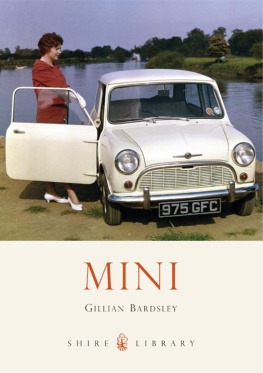Gillian Bardsley - Mini
Here you can read online Gillian Bardsley - Mini full text of the book (entire story) in english for free. Download pdf and epub, get meaning, cover and reviews about this ebook. year: 2019, genre: Detective and thriller. Description of the work, (preface) as well as reviews are available. Best literature library LitArk.com created for fans of good reading and offers a wide selection of genres:
Romance novel
Science fiction
Adventure
Detective
Science
History
Home and family
Prose
Art
Politics
Computer
Non-fiction
Religion
Business
Children
Humor
Choose a favorite category and find really read worthwhile books. Enjoy immersion in the world of imagination, feel the emotions of the characters or learn something new for yourself, make an fascinating discovery.
- Book:Mini
- Author:
- Genre:
- Year:2019
- Rating:4 / 5
- Favourites:Add to favourites
- Your mark:
- 80
- 1
- 2
- 3
- 4
- 5
Mini: summary, description and annotation
We offer to read an annotation, description, summary or preface (depends on what the author of the book "Mini" wrote himself). If you haven't found the necessary information about the book — write in the comments, we will try to find it.
Mini — read online for free the complete book (whole text) full work
Below is the text of the book, divided by pages. System saving the place of the last page read, allows you to conveniently read the book "Mini" online for free, without having to search again every time where you left off. Put a bookmark, and you can go to the page where you finished reading at any time.
Font size:
Interval:
Bookmark:
Gillian Bardsley
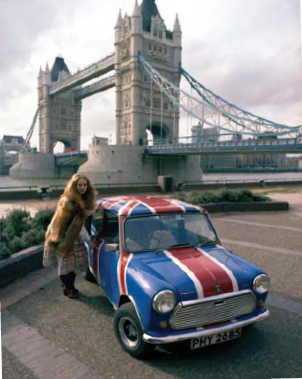
A Mini Mark III, painted in patriotic Union Jack colours, is pictured in front of another British icon, Tower Bridge in London.

SHIRE PUBLICATIONS

A Morris Mini Cooper S Mark II from 1968 with two young women wearing that symbol of the Swinging Sixties, the mini-skirt.
T HE MINI IS UNUSUAL for being closely associated with one individual in an industry whose products are usually the result of complex, and largely anonymous, teamwork. Yet the name of Sir Alec Issigonis is still recognised, for he was possibly the British motor industrys first and only celebrity.
His future status as the creator of a British icon, epitomising the youth culture which dominated the 1960s, was not obvious in his origins. Alexander Arnold Constantine Issigonis was born on 18 November 1906 in the busy Turkish port of Smyrna (now called Izmir). He was the only child of Constantine Issigonis, a marine engineer of Greek origin, and his wife, Hulda, who belonged to a German brewing family. Despite their ancestry, both his parents were born and raised in Turkey, but to complicate things further, they were also staunch Anglophiles. Constantine had spent some time in England as a young man and been given British citizenship. So young Alec was given a private English education and instilled with loyalty to a country that he had not had the opportunity to visit.
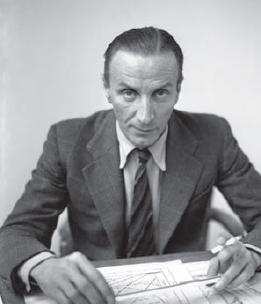
Alec Issigonis, Morris Motors project engineer, at Cowley in 1946. This was the period during which the Morris Minor, which established his reputation, was being designed.
The comfortable way of life enjoyed by Smyrnas expatriate community was rudely shattered by the First World War in which Turkey chose the losing side. As a consequence, international war was followed by civil war, and in 1922 the Royal Navy arrived to evacuate the British community. While they waited on Malta as refugees, Constantine fell gravely ill and died. Hulda and her son, now sixteen years old, crossed to Sicily and travelled the length of Europe to reach their new home in England.
Here Issigonis resumed his education, completing an engineering diploma at Battersea Polytechnic in 1928 and gradually making his way into the motor industry. Though the British economy was struggling during this period, the motor car had only been invented around forty years previously, and the industry which had grown up around it proved more resilient than many older sectors. In 1936 Issigonis was offered an opportunity as a suspension designer with Morris Motors, one of the leading motor manufacturers of the time, based at Cowley near Oxford. Two years earlier, the firms founder, William Morris, had been created Lord Nuffield in recognition of his great philanthropy.
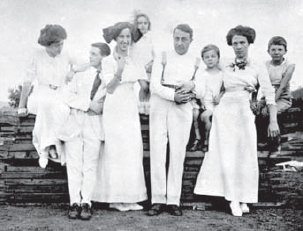
Constantine, Alec and Hulda Issigonis are fifth to seventh from left in this picture, together with their extended family in Turkey, c. 1910.
As his career began to take off, Issigonis dedicated his leisure time to motor sport, modifying a series of Austin Sevens. He spent much time both as competitor and spectator at racing circuits and hill-climbs. In 1934 he began work with his friend, George Dowson, to construct an innovative racing car completely from scratch. The resulting Lightweight Special took five years to build entirely by hand and began to compete in 1938. Motorsport was suspended for the duration of the war from 1939, but the car returned once peace was established, and enjoyed several more years of successful competition before Issigonis and Dowson retired from the amateur racing scene in 1948.
With the outbreak of the Second World War, Issigonis, as part of a reserved occupation, was officially assigned to the design of military vehicles. At the same time, the vice-chairman of Morris Motors, Sir Miles Thomas, encouraged him to work on ideas for a new small car. Though production and design of civilian vehicles was banned until 1944, most motor manufacturers continued to work discreetly on post-war designs in the hope that they could gain an advantage over their rivals when the war was over.
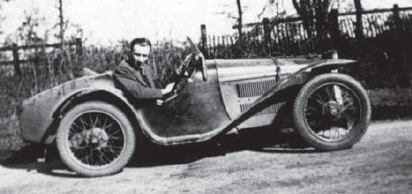
Alec Issigonis, driving his modified Austin Seven Sports near his home in Purley, Croydon, c. 1930.
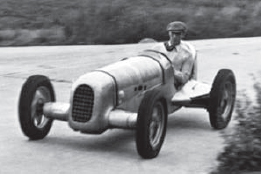
Issigonis designed and built the Lightweight Special in his spare time. It enjoyed considerable competition success in the late 1940s and taught him much about car design.

As part of the war effort, Issigonis designed an amphibious motorised wheelbarrow to be airlifted to troops in the field. In 1944, he tested it for himself on the lake at Blenheim Palace in Oxfordshire.
So, alongside armoured cars and motorised amphibious wheelbarrows, Issigonis and his small team worked away on the Mosquito project which was well advanced as the end of hostilities approached in 1945. The Mosquito was launched as the Morris Minor at the London Motor Show in October 1948. The American-influenced styling of this small car was strikingly modern, while it set new standards for its use of space, its pioneering rack-and-pinion steering and excellent suspension. It also featured remarkably small wheels, a repeating theme in Issigoniss future work. As a result, its handling and ride were impressive for a car of its size. The Morris Minors unusual appearance provoked strong antipathy from Lord Nuffield, who likened the car to a poached egg but the buying public disagreed with him. The car was a great success and was an important step towards establishing Issigonis as a leading British designer.
In 1952, however, strong overseas competition prompted Morris Motors to conclude a merger with its chief rival, the Austin Motor Company, which was based at Longbridge near Birmingham. The outcome was the formation of the British Motor Corporation (BMC). Issigonis shied away from the in-fighting which commonly accompanied such reluctant unions. He therefore decided to move to the smaller, Coventry-based firm of Alvis, where his brief was to design a luxury 8-cylinder car codenamed TA/350. During his three-year tenure at Alvis, he developed new ideas and formed relationships that would be important in his future career. As well as new work colleagues, he began his collaboration with suspension designer Alex Moulton. The TA/350 never went into production because, by 1955, Alvis had decided it was too great a risk for them to produce an expensive new model, which they feared would not appeal to their conservative customer base. By coincidence, at this very moment the chairman of BMC, Sir Leonard Lord, was looking for an innovative designer to move BMC forward. Issigonis was offered the post of deputy engineering director and returned not to Cowley, but to Longbridge, with its superior technical facilities entirely at his disposal. The story of the Mini was about to unfold.
Font size:
Interval:
Bookmark:
Similar books «Mini»
Look at similar books to Mini. We have selected literature similar in name and meaning in the hope of providing readers with more options to find new, interesting, not yet read works.
Discussion, reviews of the book Mini and just readers' own opinions. Leave your comments, write what you think about the work, its meaning or the main characters. Specify what exactly you liked and what you didn't like, and why you think so.

